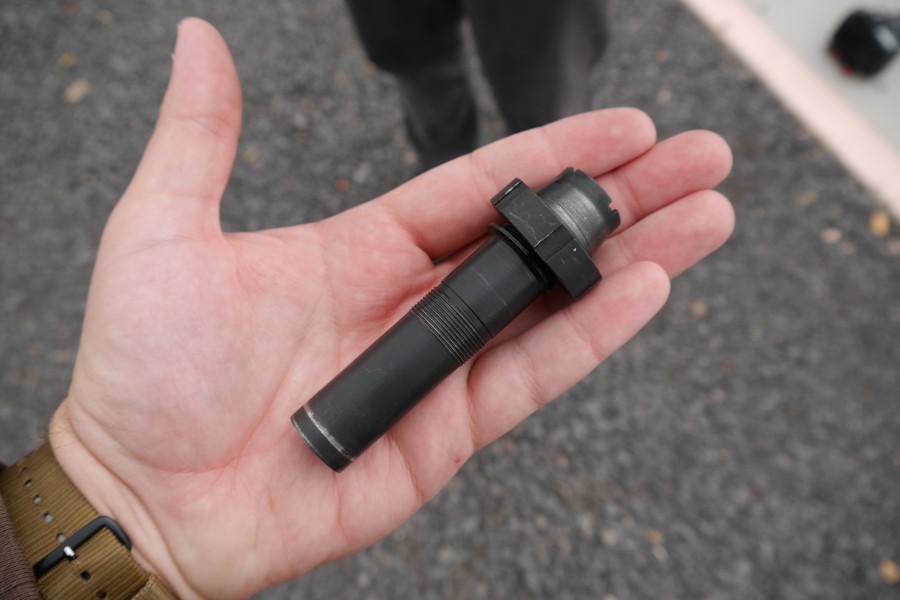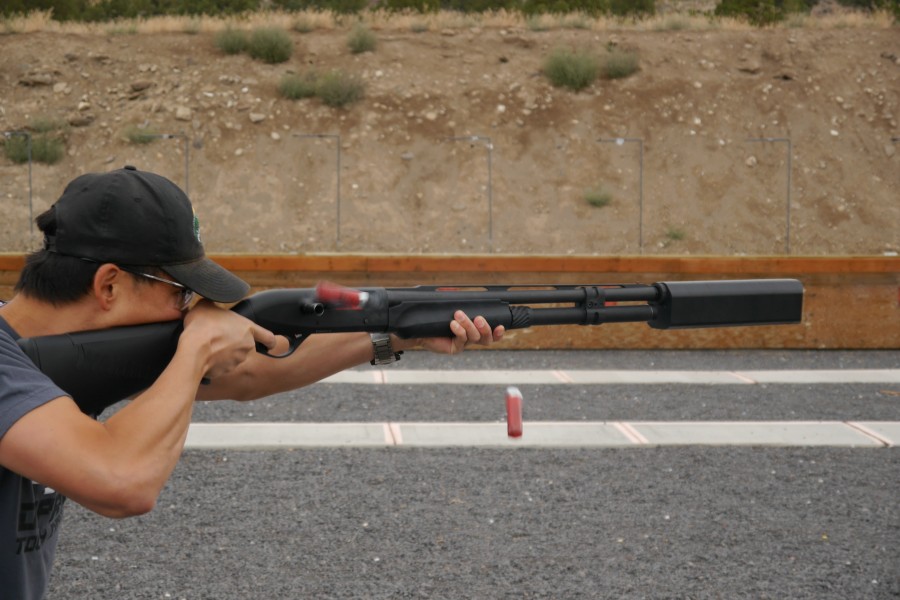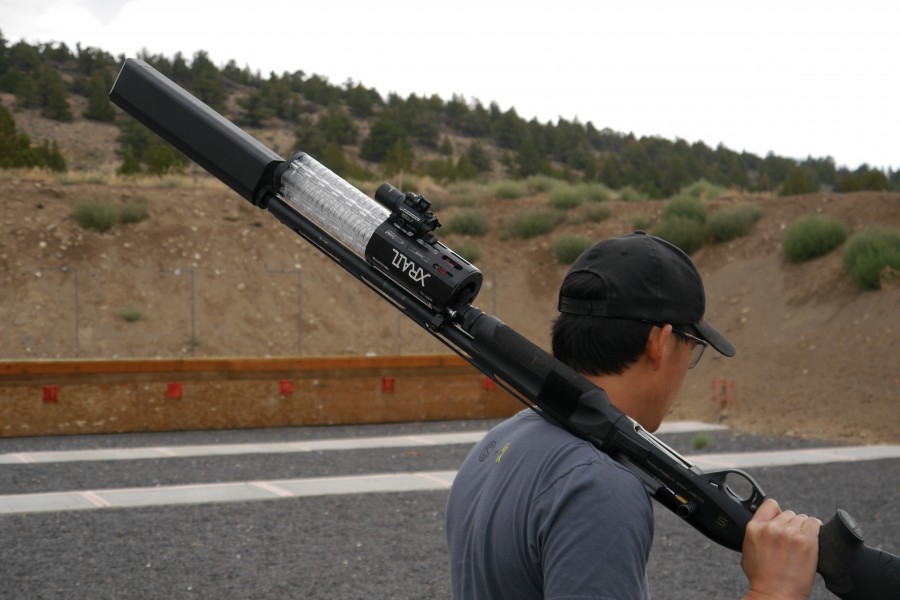Silencers are gaining popularity in the United States. In addition to the “big names” in cans it seems like every mom-and-pop gunsmith in the US now makes them as well, and as a result the market is flooded with inexpensive rifle and pistol suppressors. What the market doesn’t have, though, is a commercially available shotgun silencer. There have been a few one-off cans produced and short runs from smaller shops, but none of the “mainstream” shops have done a commercial run since silencers really started taking off. That all changed when SilencerCo introduced their Salvo shotgun silencer last month.
The very first question I had when I saw the can: how the hell does it work? Shotguns are inherently more complicated to suppress than rifles due to the nature of their ammunition — rifles use a solid projectile, but shotguns use a “wad” to propel the shot that would get stuck in a traditional baffle stack. Previous efforts have used a vented barrel design to make their shotguns quieter, but that means needing a new barrel as well as the silencer itself.
SilencerCo solved this issue by integrating a series of rails along the side of the channel in the silencer, keeping the wad centered and closed while still in the silencer and allowing it to expand once clear of the device. The system works, but even with the rails some of the plastic wadding will occasionally slip between the rails and get sliced off when the wad leaves the front of the can. For that reason, SilencerCo has designed the device to be maintained by the end user.
The silencer is capable of being disassembled with just the removal of the two rear hex screws. The baffle stack has no external housing due to the low pressure of the shotgun shells, and once the screws are removed the whole thing falls apart. One of the benefits of this system is that the size of the device can be altered by the end user — SilencerCo will be selling kits that will let users assemble the device with fewer baffles being used to make it lighter and smaller when needed. However, the silencer proper will be sold in only one size and spare baffles will not be available for sale. You can go smaller, but not bigger.
Mounting the can to the shotgun is done using the pre-existing system of choke tubes, so no modifications will need to be made to your existing guns. Assuming they take chokes, that is. SilencerCo will be coming out with a full line of silencer ready chokes for the most popular systems in the near future, but only a handful of models are supported at the moment. The plan is to have a kit available for purchase that includes the full range of chokes (cylinder to full) for your gun ready to attach to the silencer for mounting.
The system is a bit of a pain in the butt at the moment since it takes some time to configure the gun when moving between chokes, but I’m not sure there’s a better way to do it. The chokes use a tapered shoulder to connect to the silencer to ensure that the barrel and the can are lined up and to keep gasses from escaping.
With the can attached, a standard configuration shotgun will run just fine. The guys say that gas-powered shotguns like the FNH USA SLP or the Mossberg 930 series fare better than impulse based designs simply because the can adds more mass and screws with the physics a bit. While shotguns are already pretty darn quiet as-is, the silencer definitely brings things down a few notches and makes shooting downright pleasant.
As for the intended market, hunters are who SilencerCo believes will be the biggest purchasers. Just like a rifle can makes hunting much more pleasant and safe, a shotgun can greatly improves the experience for bird hunters. According to their guy on the ground bird hunting is a much more social experience than deer hunting, and adding a can into the mix makes it easier for everyone to hear the conversation and keep safe at the same time. Also, it does wonders to protect the hearing of hunting dogs.
The main downside to the Salvo is the size of the gun. Shotguns are already longer than rifles, and adding a silencer to that huge stick makes a comically large firearm. SilencerCo says that they are working on partnering with a couple gun companies to produce specially designed short barreled shotguns to accompany the silencer, but those won’t be ready for a while. In the meantime, form 1s are coming back within 45 days so cutting down your own shotgun is easier than ever.
The price right now is $1,400, which is on par for high end rifle silencers. It’s not cheap, but it’s not that expensive either. It seems to work fine, and doesn’t add as much weight to the gun as I had feared. The only question left: will it sell?









Please join me in a (resoundingly quiet) YEEEEEE HAAAAAAA!!!!
I’m a YHM fan myself, but would be willing to make an exception for a 12ga. variety while/until YHM has one.
Only millionaire hunters will buy this thing at 1400 plus the wait and 200. This won’t sell well u go dove hunting every year and would not even consider dropping 1600 on this plus I sometimes hunt in CA and suppressor is a no go there
Touche’, however, this is the only form of “suppression” I will tolerate in relation to firearms. $1,400 today. . . if there was a growing market maybe YHM could do for ~ $500?
Yep, YHM can do anything…….for half the money, and twice the weight. 😀
Wow, I guess you can count me in the “millionaire hunter” club… Ok, not so much a hunter or a millionaire. Most quality cans are in the $900-1200 range anyway, a couple hundred more for something that scratches the 12ga itch, is worth it.
Anyone playing in the NFA game, at least with any sincerity, wouldn’t balk at the price tag. Silencers, writ large, are a growing market by a considerable margin (also noted in the article). In fact, the NFA branch is busy processing tens of thousands of applications, it’s not like it’s slowing down despite the waits. With that said, e-file is seeing fast returns on F1s and paper returns on F1’s/F4’s are coming in faster than before the rampant uptick in NFA applications a couple years ago.
“Previous efforts have used a vented barrel design to make their shotguns quieter, but that means needing a new barrel as well as the silencer itself.”
Is this a big deal? Shotgun barrels aren’t expensive or hard to make, and most shotguns are designed so you can swap barrels easily.
Alternatively the inside of the suppressor could simply be vented / perforated. Like the inside of a straight-through car muffler that has holes to allow the pressure and noise to go through into the muffling material: click for photo
That’s always how I would have designed a shotgun silencer, at least. Should allow the gas to get up inside of there just like traditional baffles and not disturb the wad very much at all. You could chamfer the edges of the holes to avoid them shaving away at the wad.
Was thinking the same thing about a perforated pipe- in fact, you could take an existing barrel and drill about 6-10″ of holes from the muzzle back to be the perforated section, and then use an outer can attached to a choke tube at the front. Would be a dedicated barrel, but they’re relatively cheap and it would eliminate the problem of aligning it with the bore. I think it’s low enough pressure that you could use a hard rubber gasket or something at the rear of the outer can to prevent blowback.
Interesting, but not so interesting that I would buy it as-is (I’m also not a hunter). I’ll be anxious to see the specially made guns they come up with for it. I’d like to see the ‘box’ portion extending out of both sides rather than the bottom so that it could lie above the magazine tube, and possibly be integrated to the barrel so that it only takes one tax stamp. An 18″ integrated silencer barrel that doesn’t impede magazine capacity (at least 7+1, please) would be the holy grail for home defense.
Doesn’t seem too hard to make for yourself. A 10-12 inch barrel + 10-12 inch suppressor permanently attached.
You could probably improve the original design. Increased can volume and better baffles.
As a professional machinist, making it myself is the only thing that crosses my mind when I see something like this. The rails inside are very cool.
As a proffessional crazy person who watched way too much Macgyver I have the same attitude. The world is simple when you look at it piece by piece.
It’s a nice design but I won’t bother buying it + importing. I will just copy and improve the design for personal use.
Sucks that people in Indiana can’t own SBS’s…
If you can own suppressors you should be in the clear if you permanently attach the suppressor. If you want to use your silencer on multiple shotties just make a silencer shroud that you can fit the suppressor through.
Like this just bigger:
http://www.brownells.com/rifle-parts/barrel-parts/rifle-barrels/ruger-reg-10-22-reg-sb-x-barrel-sb-x-barrel-sku100-005-210-32513-61796.aspx
Hey look more things you can’t buy in new jersikstan
Cue the Fuds who think suppressor owners are snobs, wannabe assassins, etc……….
Mine is already on order. 😀
That Xrail system looks bad-ass – and heavy.
http://youtu.be/0cL1x_6gKOQ
Hey Nick, why do you ‘look’ like Chris Cheng??
xD
Please tell me where all of these inexpensive pistol and rifle suppressors are? Even a suppressor that costs as much as a Glock is not “inexpensive” to most people. When you can buy a can for $50 or $100 then we can maybe say they’re inexpensive. Hell if it wasn’t for the Draconian gun laws I sure suppressors would be integral on most if not all guns in the 21st century just like mufflers on cars!
I believe like ammunition and firearms, there is a 10% or 11% additional tax on each produced item on top of traditional sales tax. This is incurred by the manufacturer, and the purchaser.
Even with that, I’m not sure why /some/ pistol and .22LR suppressors aren’t $200. A “few” of the current designs for suppressors have been around for 30 years or longer.
Also pissed that the ATF doesn’t permit modular suppressors where baffles can be changed to accommodate different calibers. Yeah, you can buy a 7.62 and adapt it to your 5.56 or your .22LR if you really wanted to, but come on. The way the ATF works is if you have additional baffles uninstalled, those count as a different suppressor, and if they’re not tax stamp approved, you’re going to “Pound Me In The Ass Penitentiary”.
Actually, there are cans that are sub $500. Some are in the $300 range, for pistol, that’s certainly less than a Glock. Bottom line, just like with anything else, research both the product and the seller. You have to decide if the product will meet your requirements and if the seller will meet your pricing. Simple really….
Hmm… looks a lot like my first cell phone in the top photo. The cell phone was probably bigger and heavier, though.
Just when I thought shotguns weren’t of any interest to me. Looks like there’s a SBS in my future after all 🙂
Comments are closed.